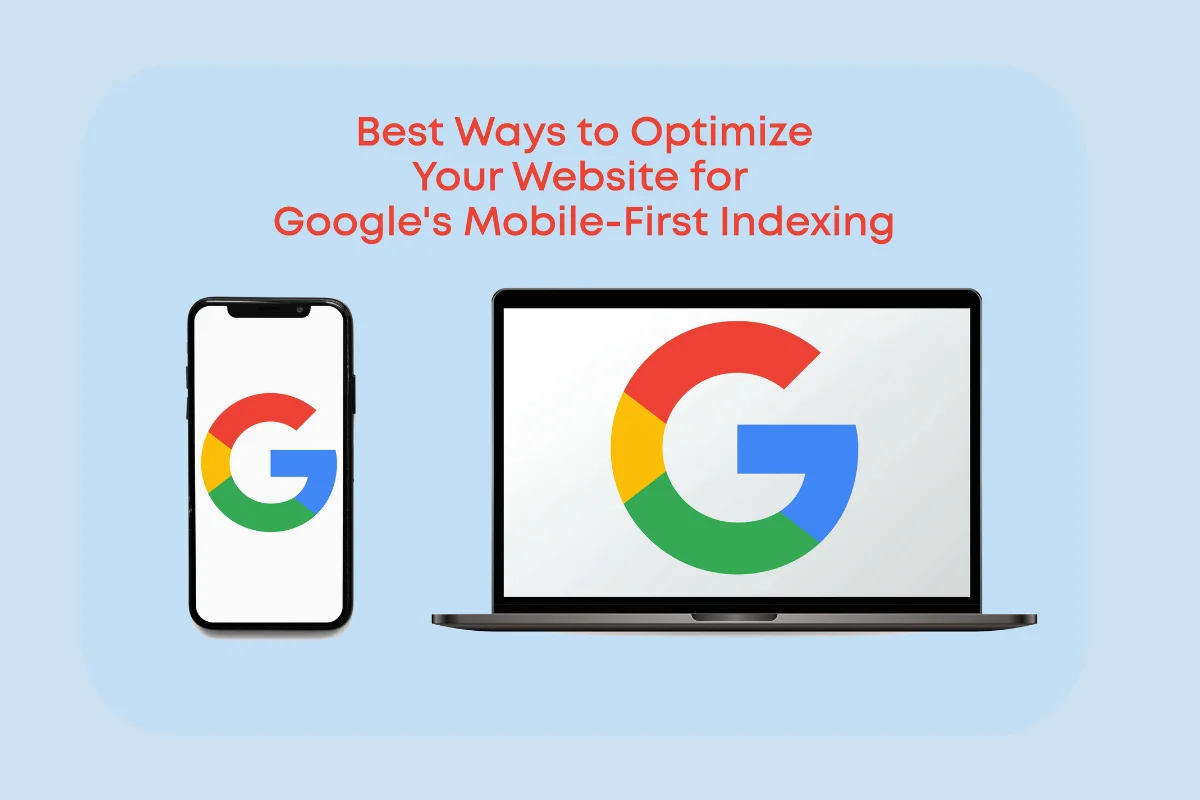The switch to mobile-first indexing by search engines reflects the growing trend of users accessing websites via mobile devices. Therefore, to maintain and improve your search engine rankings, it’s crucial to optimize your website for mobile-first indexing.
This blog will guide you through the essential steps to ensure your website is optimized for mobile-first indexing
What is Mobile-First Indexing
Mobile-first indexing means that Google primarily uses the mobile version of the content for indexing and ranking. This shift is significant because it affects how your site is evaluated and ranked. Below we will explain what is the reason behind the importance of mobile-first indexing in the digital world.

Why Mobile-First Indexing is Important?
Mobile-first indexing is important because it aligns with the growing trend of users accessing websites via mobile devices. Google now prioritizes the mobile version of a website for indexing and ranking, which means that if you don’t optimize your website for mobile-first indexing, a poorly optimized mobile site can negatively impact your search rankings. Ensuring your site is mobile-friendly helps maintain visibility, user experience, and competitiveness in search results.

Responsive Web Design
Responsive web design ensures that your website’s layout adjusts to different screen sizes, providing a consistent user experience across devices. This is a fundamental step in mobile optimization. Mobile users expect fast-loading websites. Slow load times can negatively impact user experience and rankings. Use tools like Google PageSpeed Insights to identify and fix issues that may slow down your site.
| Point | Explanation |
| Responsive Web Design | Responsive web design ensures that your website automatically adjusts its layout and content based on the screen size of the device being used. This creates a seamless experience for users, whether they are on a desktop, tablet, or smartphone. |
| Consistent User Experience | By adapting to different devices, responsive design provides a consistent user experience, ensuring that all visitors have access to the same content and functionality, regardless of their device. This improves user satisfaction and engagement. |
| Mobile Optimization | Mobile optimization is crucial for ensuring that websites perform well on mobile devices. This includes not only responsive design but also other factors like fast load times, touch-friendly interfaces, and easy navigation. |
| Impact of Slow Load Times | Slow-loading websites can frustrate users and lead to higher bounce rates. Google PageSpeed Insights and other tools can help identify elements causing delays, such as large images or inefficient code, allowing you to make necessary improvements. |
Prioritize Mobile Usability
Your website should be easy to navigate on mobile devices. Ensure that buttons are easily clickable, text is readable without zooming, and users can quickly find what they’re looking for. Structured data helps search engines understand your content better.
Ensure that the mobile version of your site includes the same structured data markup as the desktop version to maintain consistency.
Avoid Intrusive Interstitials
Pop-ups that cover the main content can frustrate mobile users and lead to higher bounce rates. Avoid using intrusive interstitials to improve user experience and maintain good rankings. Mobile users often search for local businesses.
Ensure your site is optimized for local SEO by including relevant keywords, having a Google My Business profile, and ensuring your NAP (Name, Address, Phone) information is consistent across the web.
Implement AMP (Accelerated Mobile Pages)
AMP is a technology that helps pages load faster on mobile devices. Implementing AMP can improve load times and potentially boost your rankings in mobile search results. Regularly test your site’s performance on mobile devices using tools like Google’s Mobile-Friendly Test. This will help you catch and fix any issues before they impact your rankings.

Monitor Mobile Analytics
Use Google Analytics to monitor mobile traffic and user behavior. This data will help you understand how mobile users interact with your site and identify areas for improvement. Ensure that the content on your mobile site matches the desktop version. Google uses the mobile version for indexing, so missing content could affect your rankings.

- Track Mobile Traffic Patterns: Use Google Analytics to analyze mobile traffic, identifying trends in user behavior and engagement on your site, which can reveal how mobile users are interacting with your content.
- Identify Areas for Optimization: Monitor metrics like bounce rate and session duration to pinpoint areas where your mobile site may need improvement, helping you enhance user experience and performance.
- Ensure Content Consistency: Verify that the mobile version of your site has the same content as the desktop version, as Google relies on the mobile content for indexing and ranking, ensuring no critical information is missing.
Minimize Mobile Redirects
Excessive redirects can slow down page load times. Minimize the number of redirects on your mobile site to improve performance and user experience. Large images and media files can significantly slow down your site on mobile devices. Compress these files without sacrificing quality to enhance load times.
Optimize CSS and JavaScript
Optimize your CSS and JavaScript for mobile devices by minimizing file sizes and removing unnecessary code. This helps improve site speed and functionality. Lazy loading delays the loading of images and other media until they are needed. This can speed up page load times on mobile devices and enhance user experience.

Conclusion
Optimizing your website for mobile-first indexing is no longer optional; it’s essential. By taking steps to optimize your website for mobile-first indexing, you can ensure that your site remains competitive in search engine rankings and provides a seamless experience for mobile users. Regular monitoring and updates will help you stay ahead of the curve in this mobile-first world.
Read more : How Marketing Automation Enhances Your Strategy
FAQs
Mobile-first indexing means that search engines like Google predominantly use the mobile version of your site for indexing and ranking.
Mobile users expect fast load times. Slow pages can lead to higher bounce rates and lower search rankings.
You can use Google’s Mobile-Friendly Test tool to check if your site is optimized for mobile devices.
AMP (Accelerated Mobile Pages) is a technology that helps pages load faster on mobile devices. Implementing AMP can improve load times and potentially boost mobile rankings.

Alex Mitch
Welcome to my blog! With over 10 years in digital marketing, I’ve seen its incredible impact on smaller businesses. Join me as we explore how digital marketing can grow your audience and boost your business. Whether you’re an experienced entrepreneur or just starting out, you’ll find practical tips and insights to enhance your digital marketing strategies.





